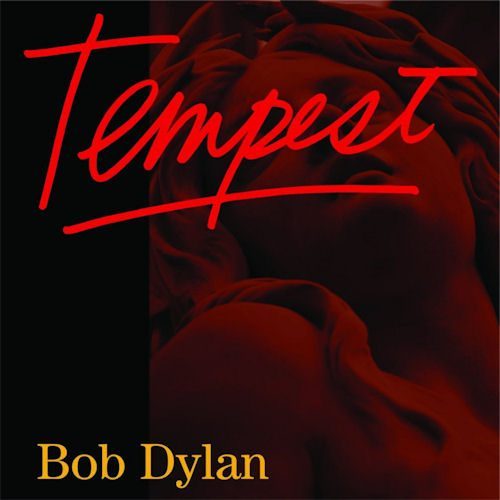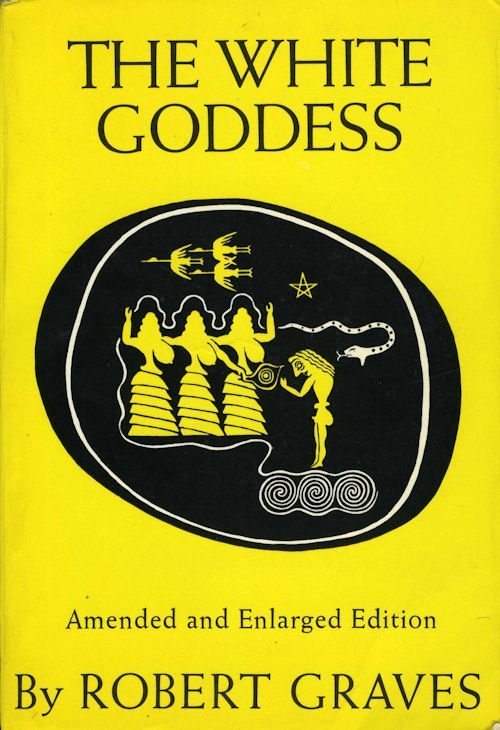BOB DYLAN – TEMPEST
TITLE: TEMPEST
ARTIST: BOB DYLAN
LABEL: COLUMBIA RECORDS
RELEASED: SEPTEMBER 11, 2012
Bob Dylan and the Great Tradition
 Bob Dylan has just released his 35th studio album, and it’s a corker. With a title that evokes Shakespeare’s final play, are his revels now ended too? Dylan denies this tight connection to his heart, of course, and makes much of the fact that Shakespeare’s play is called The Tempest, whereas his is just the single word. Be that as it may, if this is his swan song, it’s a beautiful way to go out. Not surprisingly, it evokes the blues as perhaps the primary color on his musical palette; it starts off with a train song—Duquesne Whistle—on its final run. Dylan’s great touring band—Tony Garnier, Donnie Herron, Charlie Sexton, Stu Kimball and David Hidalgo—sneaks up on you with a casual abandon, a lilting melody with soft chords, before suddenly hurtling round the bend with George G. Recelli’s drum roll to start the rock & roll journey south. Other than this framework it has little in common with Steve Goodman’s tale of the City of New Orleans also on its final run, since Dylan’s opening song (lyrics co-written with Robert Hunter) is an impassioned love song, like most, but importantly not all, of the songs on the album.
Bob Dylan has just released his 35th studio album, and it’s a corker. With a title that evokes Shakespeare’s final play, are his revels now ended too? Dylan denies this tight connection to his heart, of course, and makes much of the fact that Shakespeare’s play is called The Tempest, whereas his is just the single word. Be that as it may, if this is his swan song, it’s a beautiful way to go out. Not surprisingly, it evokes the blues as perhaps the primary color on his musical palette; it starts off with a train song—Duquesne Whistle—on its final run. Dylan’s great touring band—Tony Garnier, Donnie Herron, Charlie Sexton, Stu Kimball and David Hidalgo—sneaks up on you with a casual abandon, a lilting melody with soft chords, before suddenly hurtling round the bend with George G. Recelli’s drum roll to start the rock & roll journey south. Other than this framework it has little in common with Steve Goodman’s tale of the City of New Orleans also on its final run, since Dylan’s opening song (lyrics co-written with Robert Hunter) is an impassioned love song, like most, but importantly not all, of the songs on the album.
What is surprising, and what lifts this extraordinary record above even the high water mark set by his past four albums—from 1997’s Time Out of Mind to Together Through Life—is his sudden school mastery of what the late English literary critic FR Leavis called The Great Tradition, his definitive text on the canon of English poetry.
In Tempest, Dylan has put that canon to good use, drawing on works made accessible by The Norton Anthology—from Shakespeare to Edmund Spenser to Alexander Pope to William Blake to Omar Khayyam to Robert Graves. Are there any other contemporary songwriters who swim in these waters? Don’t ask.
Indeed, Dylan’s sustained regard for the classics of English literature is well known; when he had just completed his third album in January, 1964 he took a copy of The Times They Are A-Changin’ to the Spanish island of Majorca to hand it personally to the World War I poet Robert Graves, who had been living there since he barely survived the war—so barely that his death had actually been reported. Dylan was impressed with Graves; unfortunately the feeling was not mutual and his pilgrimage was unwelcome—to Graves he was just a pretender to the throne of poetry. Indeed, to an entire generation of American academic poets Dylan was little more than an annoyance and a distraction who made their job of teaching poetry much more difficult.
But Dylan has stayed the course and no one laughed when he was awarded a special Pulitzer Prize, or nominated for the Nobel Prize in Literature,
 On Tempest his song Soon After Midnight presents a portrait of Graves’ White Goddess—his name for the muse of poetry—that is indelible—the late Joseph Campbell might have called her the Muse With a Thousand Faces. Dylan gives her three names: Honey, Charlotte and Mary, before settling on the one Edmund Spenser gave her: The Faerie Queene. It’s a brilliant way out of the corner he has resolutely painted himself into.
On Tempest his song Soon After Midnight presents a portrait of Graves’ White Goddess—his name for the muse of poetry—that is indelible—the late Joseph Campbell might have called her the Muse With a Thousand Faces. Dylan gives her three names: Honey, Charlotte and Mary, before settling on the one Edmund Spenser gave her: The Faerie Queene. It’s a brilliant way out of the corner he has resolutely painted himself into.
Graves wrote a masterful book describing the natural symbols of poetry, in which the moon is the surrogate for the Muse; so of course she also makes her appearance in Dylan’s ode to The White Goddess; I wonder if Graves might have welcomed the traveler home this time around; too late, England’s great expatriate lyric poet passed on in 1985.
The third song on this ten-song album noir is Narrow Way, in which Dylan finds a firmer footing in relation to the Goddess—
It’s a long road
It’s a long and narrow way;
if I can’t work up to you
You’ll surely have to work down to me someday.
It also harbors a remarkable prophetic foreshadowing of the late songs on the album, in the verse:
Ever since the British burned the White House down
There’s a bleeding wound in the heart of town
I saw you drinking from an empty cup
I saw you buried/I saw you dug up.
One senses the Atlantic will be crossed again,
this time with tragic consequences.
But this time the Goddess has her hands full; for after she has broken his heart, and after “even death has washed his hands of you,” Bob has
A heavy-stacked woman
With a smile on her face
And she has crowned my soul with grace
I’m still hurting from an arrow that has pierced my chest
I’m going to have to take my head and bury it between her breasts;
and finally The Rubaiyat’s translator Edward Fitzgerald’s great line saves the day: “The moving finger…is moving on…”
But his salvation doesn’t last; in the very next song, Long and Wasted Years Dylan’s portrait of a life of quiet desperation leads him to say,
I wear dark glasses to hide my eyes
There are secrets in them that I can’t disguise.
We cried on a cold and frosty morn
We cried because our souls were torn
So much for tears
So much for these long and wasted years.
Song #5, Pay In Blood, is perhaps the darkest song on the album,
I’m sworn to uphold the laws of God
You can put me out in front of a firing squad.
He may have a mansion in Malibu, but that’s not the house Dylan lives in:
Man cannot live by bread alone
I’ll pay in blood, but not my own.
I got something in my pocket make your eyeballs swim
I got dogs that could tear you limb from limb
You’ve got the same eyes your mother does
If only you could prove who your father was
I been through hell
What good did it do
You bastard—I’m supposed to respect you?
I’ll take my pill, and sleep alone
I’ll pay in blood, but not my own.
Where do you go from there? In song #6 Dylan turns to England’s most famous Childe ballad, Barbara Allen, “In Scarlet Town, where I was born…” and transforms it into a slow, moody, haunting song of trapped regret and redemption. His Scarlet Town is a long way from Burl Ives’. Here in place of his “heavy-stacked woman,” is a “flat-chested junkie whore.” And you suddenly realize Dylan has been here before, in his very first (eponymous) album, with the American prostitute ballad The House of The Rising Sun.
Then Dylan takes a long look back into Robert Graves’ well-traveled roads, who wrote a series of historical novels about the Early Roman Kings (such as I, Claudius) of Dylan’s Tempest song #7, joining a blues beat to a tale of antiquity: “Ding dong daddy/You’re coming up short/Gonna put you on trial/In a Sicilian court”…about a crass, materialistic society on the verge of a fall (who could he have been thinking of?); but again he finds a momentary salvation: “I ain’t dead yet/My bell still rings/I keep my fingers crossed/Like the early Roman Kings.”
Song #8 starts out with an evocation of another English ballad, Gypsy Davy, “It was late last night the boss came home…” …”With all the nobility of an ancient race…” but it turns into an outlaw ballad about Henry Lee, who dies at the hand of a Tin Angel—yet another incarnation of the White Goddess, who “pierces him to the heart…and puts the blade to his heart and “ran it through.” Yet more complications ensue, as it becomes a murder ballad of a lovers’ triangle. Dylan almost magically transforms a simple homage to a traditional ballad form into a complex interrelated poem of love, class conflict and ultimately murder. It’s a testament to how deeply he has absorbed both traditional folk ballad forms and the literary tradition.
Then, with the title song #9, Tempest, Bob Dylan rises to a height of simple eloquence that is the profound fruit of his fifty year devotion to the craft of songwriting: a retelling of the tragic story of the sinking of the Titanic, in an epic forecastle sea shanty, 14 minutes long. The tune is a simple folk-like melody with no misguided attempt to bring in the many tricks of his trade—no hook, no bridge, just the same beautiful tune throughout, and a barely noticeable chorus to break the flow of the narrative—this is Dylan’s Sir Patrick Spens, longer even than Sad Eyed Lady of the Lowlands, which took up an entire side of his second album on 1966’s Blond On Blonde. He uses the movie Titanic in the same way Woody Guthrie used John Ford’s movie to tell the story of The Grapes of Wrath in his Ballad of Tom Joad. It is masterful, moving and gorgeous.

And yet the title song is not the greatest song on Tempest; Dylan truly saves the best for last—his homage to his and humanity’s friend John Lennon, Roll On, John.
The entire song takes place in between the shock of the bullet that “shot him in the back,” and Lennon’s breathing his last breath in the penultimate verse. It’s a stroke of genius: you suddenly realize that Lennon is alive throughout the song, since Dylan ends the song as Lennon is “about to breathe his last.” He confers immortality on his friend in the very structure of the song, including its 18th Century perfectly rhymed couplets.
But romantic that he is, Dylan is also a realist, and pays tribute ultimately not by trying to claim, like Alfred Hayes did for labor troubadour Joe Hill, that he is “the man who never died.” Dylan finally leaves Lennon like Shakespeare left Hamlet, something close to “Goodnight sweet Prince,” with “cover him up and let him sleep.”
The way Dylan gets there is the stroke of genius: he essentially lets English mystic poet William Blake finish the song for him:
’Tiger, tiger burning bright
In the forest of the night’
Shine your light
Moving on
You shine so bright
Roll on, John.
What a brilliant and heart-breaking resolution to this great portrait of John Lennon’s life and death: he folds him into the great tradition of English poetry out of which he emerged in perhaps its most unlikely corner—the working-class port town of Liverpool, England. From Shakespeare to William Blake, Bob Dylan has in this late masterpiece gone beyond his early American roots in the blues, and embraced what Victorian poet and critic Matthew Arnold once called “the best that has been thought and said.”
America does not need to place a laurel on his brow; uncrowned he may be; Bob Dylan is our poet laureate. How lucky we are to have him, still creating great music into his seventh decade.
Finally, think of Tempest as Dylan’s album of ghost stories, for there are many such tales here; best to listen to it as I did, late at night, with a single lamp burning, just as his second song invites, Soon After Midnight. His old, wizened voice strangely provides great comfort, even in the midst of these late-in-life rites of passage. Dylan’s tiger, like Blake’s, is still burning bright. Fifty years after his first record, his bell still rings.
And that long ago album Bob Dylan brought to Robert Graves? Boots of Spanish Leather was on that album; Dylan’s ballad is now in the Norton Anthology of Poetry.
Ross Altman may be reached at greygoosemusic@aol.com













